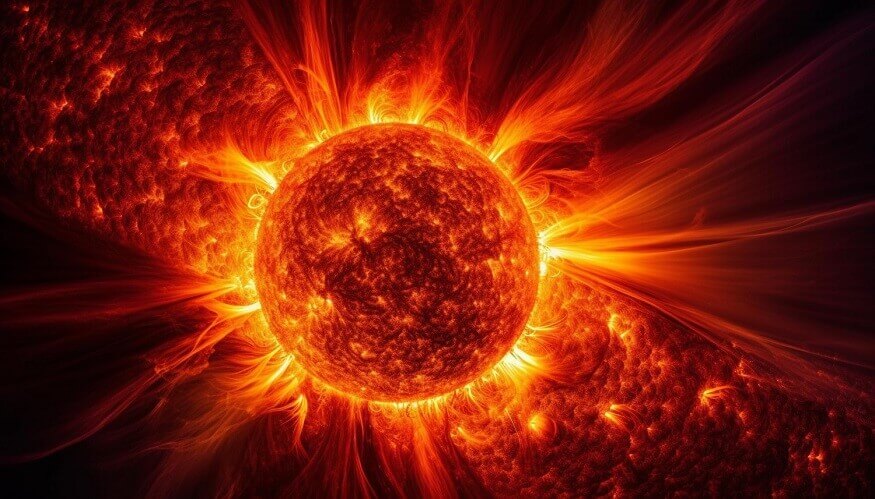Sun energy is the term for solar radiation that can create heat, trigger chemical reactions, or create electricity. The total solar energy incident on Earth is far greater than the global energy needs now and in the future. This highly distributed source can meet all future energy demands if properly exploited. Earth’s atmosphere and clouds, which absorb or scatter as much as 54% of the incoming sunlight, cause a comparatively small additional loss. Nearly half of the sunlight that reaches the ground is visible light, followed by infrared radiation at a rate of 45% and lower amounts of ultraviolet and other types of electromagnetic radiation.
Basics of Solar Energy
The Advantages of solar Energy are as follows:
- Reliability: The energy can be stored in batteries, eliminating any unreliability.
- Utility cost reduction: Utility costs are reduced.
- Free energy: It can be easily harnessed.
The disadvantages of solar energy include:
- Low production during winters and on cloudy days.
- Expensive installation and initial material costs.
- High space consumption.
Also Read: Fun science activities for kids to do at home
Solar Energy Types:
Mechanical devices are used in active solar energy to collect, store, and disperse energy. One of the basics of solar energy. Solar power concentrating: This is a sort of thermal energy utilised to generate solar power electricity.
Solar Energy Initiative
Solar energy – One of the simplest scientific experiments for your school fair science project is the experiment on the efficiency of the solar heating functioning model. This functional model is quick, easy, and extremely enlightening. The outcome may differ if the project is carried out outside due to wind and weather conditions, hence it is recommended that the experiment be carried out indoors. Reflectors focus solar radiation in one tiny area to capture and store heat energy in this solar heater project. This experiment will demonstrate the effectiveness and basics of solar energy.
Materials Required
- A wooden stand
- A thermometer
- A concave or converging mirror
- A tube for liquid flow
- Black paper
Procedure:
- The wooden stand should be mounted.
- Pieces of black paper should be rolled around the tube.
- The tube should be attached to the concave mirror in such a way that sunlight is concentrated in one direction.
- The tube should be filled with tap water.
- After 30 minutes, the temperature of the tube should be recorded.
Observations
The efficiency of the concave mirror solar heater can be calculated by dividing the temperature increase by direct sunlight. Eventually, the temperature of the water increases after 30 minutes as heat is transferred through the concave mirror and concentrated on the tube.
Also Read: 10 Ways to Create a Greener Future
The Uses of Solar Energy
Water heating: Electric heaters and gas are replaced by solar energy, with efficiency being increased by 15-30%.
Heating of swimming pools: Solar blankets are utilised to maintain the pool’s warmth. The other method involves the utilisation of a solar water heater to retain the warmth of the water.
Cooking purposes: Food is cooked using solar cookers, which utilise solar energy for heating, cooking, and pasteurising. A solar cooker consists of an elevated heat sink so that when food is positioned within it, it is cooked thoroughly.
Power of the Sun
The massive ball of fire that provides us with light and sunshine every day is much more than just bringing us much-needed Vitamin D and energy. Apart from the life-giving tangible properties of the sun, life for our minds and mental health is also provided by this bountiful and beautiful star. Beaches are lain on while sunbathing, and its rays are eaten. During golden hour, people gather in parks or restaurants. Nothing beats the beauty and strength of the power of the sun on one’s skin, in one’s life, and in one’s heart.
Is solar power a clean Energy source?
Yes, a renewable and infinite energy source is represented by solar power, and no harmful greenhouse gas emissions are created by it – as long as the power of the sun continues to shine, energy will be released.
A rather small carbon footprint is already possessed by solar panels, as they can last for over 25 years. Additionally, the materials utilized in the panels are increasingly recycled, so the carbon footprint will continue to shrink.
PV technology was born in 1954 when the silicon PV cell capable of absorbing and converting enough of the sun’s energy into power to run every day electrical equipment was developed by Daryl Chapin, Calvin Fuller, and Gerald Pearson at Bell Labs in 1954 – the first solar cell of its kind. Today, solar energy powers satellites and spacecraft orbiting Earth.
Also Read: Oscillatory motion – everything you need to know
How is electricity from solar energy exactly produced?
Usually, solar panels are made from silicon or another semiconductor material and installed in a metal panel frame with a glass casing. When exposed to photons of sunlight (very small packets of energy), electrons are released from this material, producing an electric charge.
This electric current (specifically, direct current or DC) is created by this PV charge, which is captured by the wiring in solar panels. Subsequently, an inverter converts this DC electricity into alternating current (AC). AC is the type of electrical current used when appliances are plugged into normal wall sockets.
What are solar farms?
Solar farms also referred to as solar parks or solar fields, are characterized by large areas of land where interconnected solar panels are positioned together over many acres to harvest substantial amounts of solar energy simultaneously. Large-scale solar energy generation designed for connection directly to the grid is represented by solar farms, in contrast to individual solar panels that are typically used to power a single home or building.
Also Read: Amazing fun facts about Sun
Conclusion
At EuroSchool, Kids get to understand in-depth knowledge about solar energy and how we use it. That said, the rate at which electricity is generated by solar panels does vary depending on the amount of direct sunlight and the quality, size, number, and location of panels in use. The power of the sun has a massive impact on our lives.











